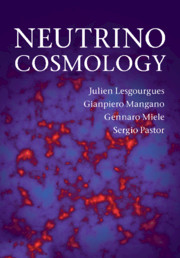Book contents
- Frontmatter
- Contents
- Preface
- 1 The basics of neutrino physics
- 2 Overview of the Standard Cosmological Model
- 3 Neutrinos in the early ages
- 4 Neutrinos in the MeV age
- 5 Neutrinos in the cosmic microwave background epoch
- 6 Recent times: neutrinos and structure formation
- 7 Cosmological neutrinos today
- References
- Index
4 - Neutrinos in the MeV age
Published online by Cambridge University Press: 05 March 2013
- Frontmatter
- Contents
- Preface
- 1 The basics of neutrino physics
- 2 Overview of the Standard Cosmological Model
- 3 Neutrinos in the early ages
- 4 Neutrinos in the MeV age
- 5 Neutrinos in the cosmic microwave background epoch
- 6 Recent times: neutrinos and structure formation
- 7 Cosmological neutrinos today
- References
- Index
Summary
Why me? Why now? These are the kind of questions that cosmological neutrinos could ask themselves about the strange coincidence of relevant facts at the MeV range of temperatures. The four known forces of Nature all play a role in this very interesting epoch. When the universe was from one-tenth of a second to a few minutes old, neutrinos experienced decoupling from electromagnetic plasma while flavour neutrino oscillations became effective, and they witnessed electron–positron annihilations and in the meantime were involved in the business of fixing the initial conditions for the primordial production of light nuclei. All these processes, which in principle could have occurred in the early universe well separated in time, depend upon the values of a bunch of unrelated parameters such as the Fermi constant, the neutrino mixing angles and squared mass differences, the electron mass and the binding energy of nuclei, in particular that of deuterium. The fact that all these events take place almost simultaneously means that they cannot be understood by a back-of-the-envelope calculation. Once more neutrinos put out a challenge to physicists.
In this chapter we first consider in Section 4.1 the process of relic neutrino decoupling in more detail than in Chapter 2, going beyond the instantaneous decoupling approximation in which neutrinos simply no longer interact with other particles below a certain temperature TνD. To this end, one should solve the Boltzmann integro-differential equations for the neutrino momentum distributions, with essentially no approximations.
- Type
- Chapter
- Information
- Neutrino Cosmology , pp. 134 - 197Publisher: Cambridge University PressPrint publication year: 2013

